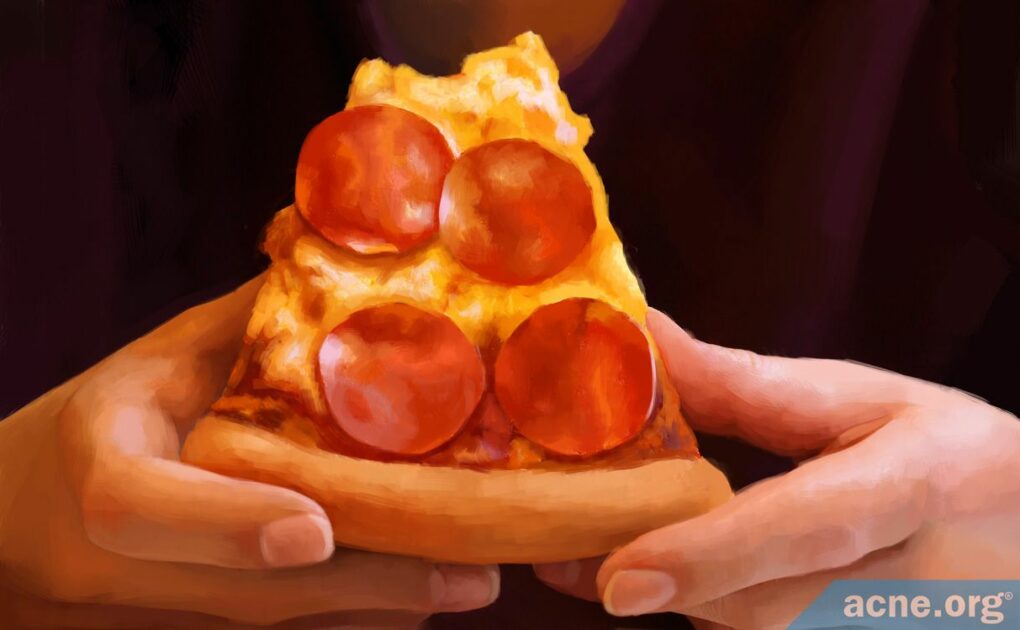Follow These Suggestions to Enjoy Pizza When You Have Acne

The Essential Info
I hesitate to even write an article like this because my youth was dominated by avoiding certain “bad foods for acne” I would read about. As you read through this information, keep in mind that having a few slices of pizza on occasion is likely perfectly fine. However, since knowledge is power, here is the low-down on pizza and acne.
___
The dermatological community still does not know how, and to what degree, diet might impact acne. Until we have better studies, everything regarding diet and acne will remain fuzzy. However, we do have some initial evidence that points toward the possibility that:
- High glycemic (high carb) foods may not be ideal when it comes to acne. Since pizza is high carb, this could be a potential concern.
- Dairy products might also not be ideal for acne, but evidence for this is still insufficient to draw any conclusions. Since pizza is covered with cheese, this could also be a potential concern.
- Consuming a high-calorie diet may not be the best idea if you have acne. Pizza is high in calories, so this is something to be aware of.
However, pizza can also be loaded with potentially beneficial ingredients like vegetables. So, as with most things in life, it comes down to moderation. From the evidence we have, it is probably not a great idea to eat pizza as a main part of your diet if you are acne-prone, but having a slice or two on occasion may be perfectly fine.
If you want to enjoy pizza in the most responsible way, choose a thin crust variety and load it up with veggies!

The Science
- Skip Down to Should I Eat Pizza if I Have Acne?
- Pizza Crust (May Not Be Ideal for Acne)
- Cheese (Might Not Be Ideal for Acne, But We Really Do Not Know)
- Sauce – It’s a Mixed Bag
- Meat Toppings (May Not Be Ideal for Acne)
- Vegetable Toppings (May Be Beneficial for Acne)
- Fun Ways To Keep Enjoying Pizza
Despite extensive and ongoing research,1-18 scientists still do not know exactly how diet impacts acne. This means that we do not know, for sure, whether pizza leads to more acne. However, the evidence we do have so far points towards the possibility that:
- High glycemic (high carb) foods may not be the best idea if you have acne. Pizza crust is high glycemic.
- Dairy products might also not be ideal for acne. Pizza is covered with cheese.
- High caloric foods might not be ideal for acne. Pizza is a high-calorie food.
But eating pizza is truly only a concern if you eat too much of it. If eaten in moderation, pizza is most likely fine for acne.
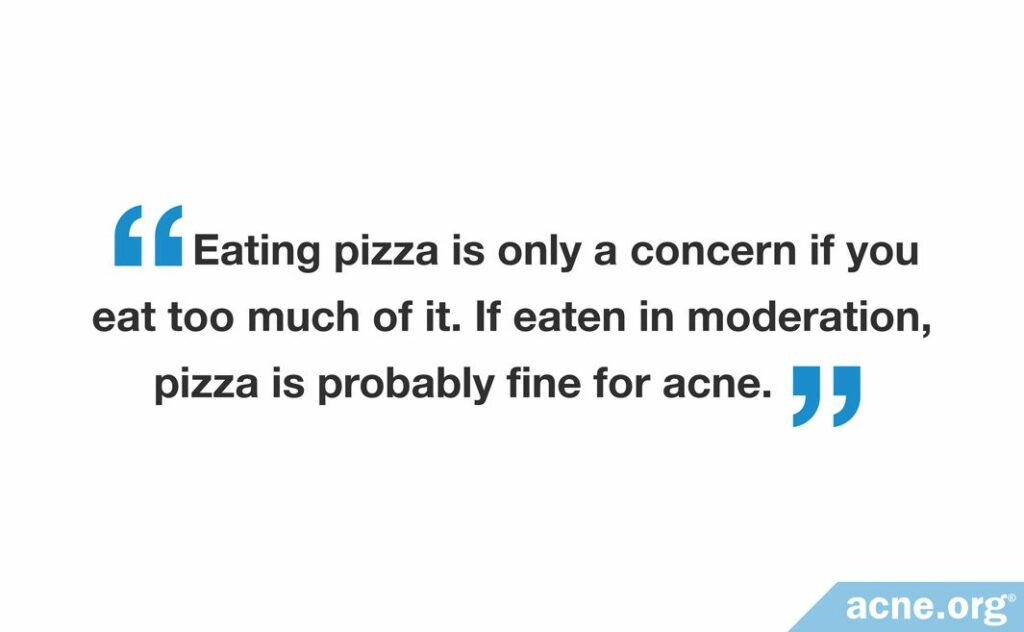
In the interest of covering this topic as thoroughly as possible, let’s now look at what the research says about pizza ingredients and acne. As you read this list, keep in mind again that I am not saying you should never eat pizza, and the jury is still out regarding any impact of diet on acne.
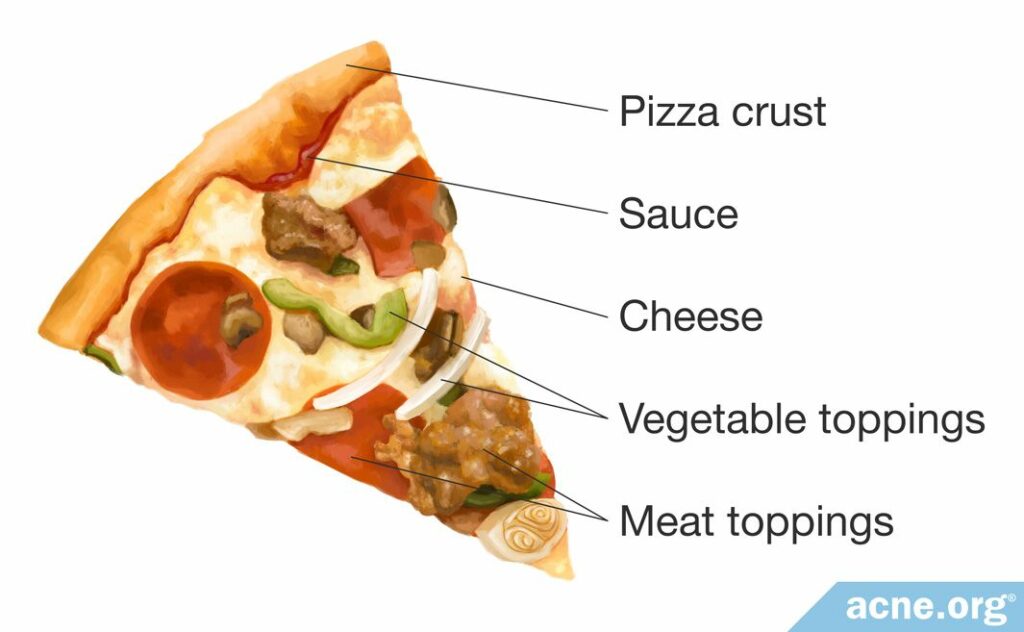
- Pizza crust: Bread of any kind, including pizza crust, may not be ideal for acne.
- Cheese: While there is less evidence showing that dairy products might not be ideal for acne, there are hints that point toward that possibility.
- Sauce: Vegetable-based foods are probably beneficial for acne, but pizza sauce is a combination of vegetables and sugar, so it’s a mixed bag.
- Toppings: Depends on the type of toppings:
- Meat toppings: Meat toppings like pepperoni and sausage are low glycemic, but also contain lots of calories. Eating a lot of calories may not be good for acne.
- Vegetable toppings: Vegetables are probably beneficial for acne, so load up your pizza with veggies!
IMPORTANT: Nobody knows how diet affects acne. What we are about to go into is not scientific fact. We are years away from knowing whether diet does in fact directly affect acne, and if so, to what degree. But, let’s go ahead and explore each of these ingredients in more detail and see how they might possibly affect acne.
Pizza Crust – High Glycemic Food – May Not Be Ideal for Acne
The glycemic load is a measurement that determines how much a food will cause an increase in the amount of sugar in your blood. High glycemic foods (e.g. white bread) lead to a high amount of sugar in the blood, and low glycemic foods (e.g. green peppers) lead to a low amount of sugar in the blood.
Pizza crust is a high glycemic food. This means that when you eat pizza crust, it leads to a spike of sugar in the blood.
So, what does this mean for acne?
Scientists have performed several studies to examine whether eating high glycemic load foods causes acne. Most of these studies have found that people who eat a lot of high glycemic load foods develop more acne.1-9 However, the studies only examined a small number of people, so more research is needed. A group of researchers summarized the results of these studies in a so-called systematic review.9
Expand to read details from systematic review

The systematic review was published in the journal Critical Comments in Biomedicine in 2020. The researchers looked at 11 studies published from 2005 to 2017, which included a grand total of 50,126 male and female participants. After reviewing these studies, the scientists concluded that the glycemic load of the foods a person consumes might contribute to how likely he/she is to develop acne. They also wrote that a low glycemic load diet might improve acne.9
Cheese – Dairy Product – Might Not Be Ideal for Acne, But We Really Do Not Know
According to some initial hypotheses from some dermatology researchers, any dairy product, including the cheese on pizza, might not be ideal for acne.

The authors of a 2014 article in the Journal of the Academy of Nutrition and Dietetics write, “Milk may contribute to acne development because of the hormonal, carbohydrate, or protein content. Milk contains a magnitude of hormones, including reproductive, nonreproductive, and growth hormones, which may individually or synergistically influence acne development.”11
In other words, milk has a lot of hormones, and these hormones might potentially trigger more acne.
Since cheese is made from milk, it also contains these hormones. However, cheese is not the same food as milk. Specifically, cheese contains active cultures which may be beneficial for the gut and thus may lead to better health, including skin health. However, since cheese is made from milk, it is possible that if milk ends up in fact being bad for acne, cheese may also suffer the same fate. So far, the limited evidence on cheese is inconclusive.
To learn more about the studies on dairy and acne,12-14 click below.
Expand to read details on research
Recently, 4 groups of researchers performed systematic reviews of all the research on dairy and acne to date. This means that the scientists combed through all the studies on dairy and acne and analyzed them to come to an overall conclusion.
We should note that the studies included in the systematic reviews were mainly performed through questionnaires that asked people about their diets and acne. Questionnaires are not a reliable method of obtaining data because people can say whatever they want on a questionnaire. A better research method would be a randomized controlled trial where scientists divide participants into 2 groups: one group that consumes dairy and one group that does not consume dairy in order to determine whether dairy causes acne. Until more randomized controlled trials are performed, we will not be sure about what effect, if any, dairy products, including cheese, may have on acne.
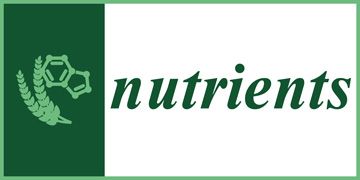
The first systematic review, published in the journal Nutrients in 2018, looked at studies on a total of 78,529 participants. The authors came to the conclusion that any dairy is associated with acne. They wrote, “In conclusion, any dairy, such as milk, yogurt, and cheese, was associated with an increased [risk] for acne in individuals aged 7 – 30 years.”19
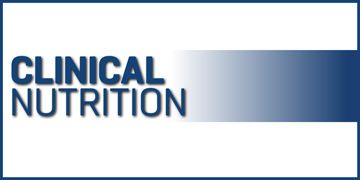
The second systematic review, published in the journal Clinical Nutrition in 2019, analyzed 14 studies on dairy and acne. The review authors concluded that all types of milk are associated with acne, but found no connection between yogurt and acne or cheese and acne. They wrote, “In this meta-analysis we found a positive relationship between dairy, total milk, whole milk, low-fat and skim milk consumption and acne occurrence. [On the] contrary, no significant association between yogurt/cheese and acne development was observed.”20

The third systematic review was published in the journal Scientific Reports in 2020. The researchers examined 35 studies on dairy and acne, and concluded that eating cheese, yogurt, and ice cream had no significant impact on acne. With regard to milk, they wrote, “the results suggest that high milk intake may increase the risk of more severe acne. However, this result should be interpreted with caution.”21

The fourth systematic review was published in the journal JAAD International in 2022. The researchers examined 34 studies looking at the link between diet and acne. They concluded that dairy products can aggravate acne in young people, but only in some ethnic groups. Specifically, they found that people from Western countries such as the United States and countries in Europe were more prone to developing dairy-associated acne. On the other hand, the researchers found no significant link between dairy consumption and acne in young people in Asia. The review authors wrote, “Despite mixed evidence, we concluded that increased dairy intake may exacerbate acne among young people in nations with a prevailing Western diet, such as the United States, Europe, and Australia.“22
Sauce – It’s a Mixed Bag
Pizza sauce is usually made with tomatoes, spices, and sugar. Each of these may have a different impact on acne.
- Tomatoes: Vegetables, including tomatoes, are high in antioxidants. Antioxidants are vitamins and minerals that protect the body from inflammation. Since acne is an inflammatory disease, antioxidants might help reduce acne symptoms.13,14
- Spices: It’s unclear if spices play any role in acne. For now, we can assume they do not have much effect.
- Sugar: Sugar is a high glycemic load food. This means that eating sugar will cause an increase in the amount of sugar in your blood. This may not be ideal for acne.
Meat Toppings – High-Calorie Food – May Not Be Ideal for Acne
Foods that contain a lot of calories, like pizza, may not be ideal for acne. Meat toppings also contain calories, so adding meat toppings to pizza results in even more calories.
How might a high-calorie diet affect acne? Researchers believe that eating lots of calories may affect certain hormones involved in acne. These hormones include insulin hormones, which help to regulate the amount of sugar in the blood. Research has found that eating a high-caloric diet increases the amount of insulin hormones, while eating a low-caloric diet decreases the amount of insulin hormones. This is important for acne because insulin hormones control skin oil production. So, the more insulin there is, the more skin oil there is, which might lead to more acne. Since eating a lot of calories may increase the level of insulin hormones, a high-calorie diet may not be ideal for acne.15-18
Since adding meat to pizza increases the total amount of calories, just keep this in mind.
Vegetable Toppings – High in Antioxidants – May Be Beneficial for Acne
Vegetables may be beneficial for acne because vegetables are high in antioxidants. Ensuring adequate levels of antioxidants may help to lower inflammation. Since acne is at its core an inflammatory disease, anything that can help lower inflammation is welcome.13-16
So, if you like the taste, don’t hesitate to add lots of vegetables to your pizza!
So, Should I Eat Pizza if I Have Acne?
Pizza contains some ingredients that may not be ideal for acne, like the crust, cheese, and high calorie meat toppings. But, it also contains other ingredients that could be beneficial to acne, like tomato sauce and vegetables. From the evidence we have, it’s probably fine to eat a slice or two on occasion, but gorging oneself on pizza may not be the best idea.
Fun Ways To Keep Enjoying Pizza
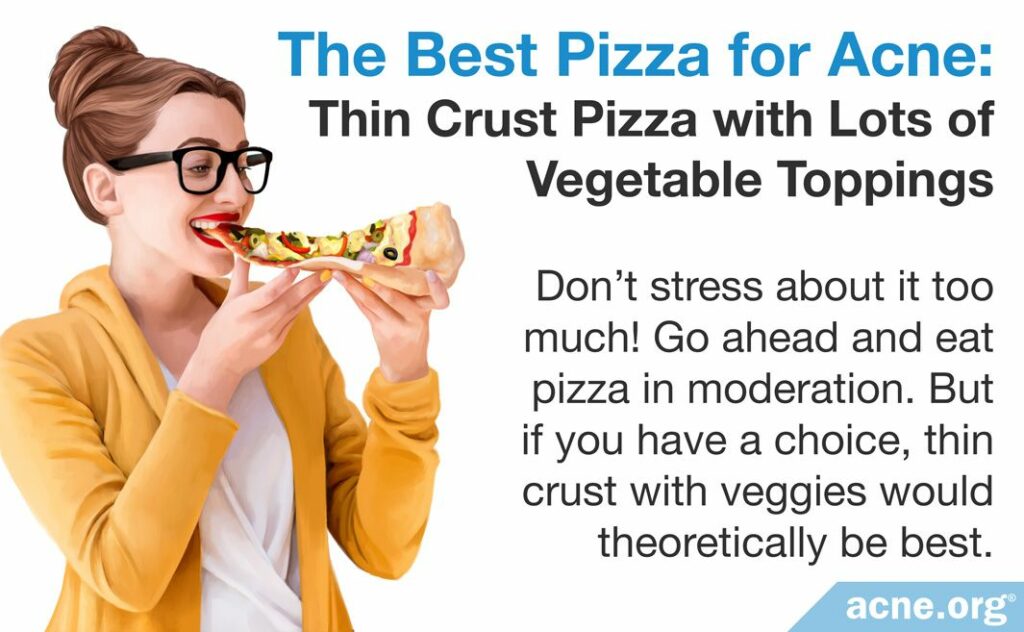
If you do decide to eat pizza, try to choose pizza that contains:
- Thin crust: Thin crust pizza contains less bread. This will help lower the glycemic load and decrease the impact on blood sugar levels.
- Lots of vegetables: Eating lots of vegetables on your pizza is a great way to add antioxidants to your diet.
And perhaps most importantly, consider your calories and eat in moderation. A sudden increase in calories can increase insulin hormones that could lead to a breakout.17,18
References
- Smith, R.N., Mann, N.J., Braue, A., Makelainen, H. & Varigos, G.A. A low-glycemic-load diet improves symptoms in acne vulgaris patients: A randomized controlled trial. American Journal of Clinical Nutrition 86, 107-115 (2007). https://www.ncbi.nlm.nih.gov/pubmed/17616769
- Smith, R.N., Mann, N.J., Braue, A., Makelainen, H. & Varigos, GA. A low-glycemic-load-diet versus a conventional, high-glycemic-load diet on biochemical parameters associated with acne vulgaris: A randomized investigator-masked, controlled trials. Journal of American Academy of Dermatology 57, 247-256 (2007). https://www.ncbi.nlm.nih.gov/pubmed/17448569
- Smith, R.N., Mann, N., Makelainen, H., Roper, J., Braue, A. & Varigos, G. A pilot study to determine the short-term effects of a low glycemic load diet on hormonal markers of acne: A nonrandomized, parallel, controlled feeding trial. Molecular Nutrition Food Research 52, 718-726 (2008). https://www.ncbi.nlm.nih.gov/pubmed/18496812
- Smith, R.N., Braue, A., Varigos, G. & Mann, N.J. The effect of a low glycemic load diet on acne vulgaris and the fatty acid composition of skin surface triglycerides. Journal of Dermatological Science 50, 41-52 (2008). https://www.ncbi.nlm.nih.gov/pubmed/18178063
- Zaenglein, A.L. et al. Guidelines of care for the management of acne vulgaris. Journal of the American Academy of Dermatology 74, 945-973 (2016). https://www.ncbi.nlm.nih.gov/pubmed/26897386
- Reynolds, R.C., Lee, S., Choi, J.Y., et al. Effect of the glycemic index of carbohydrates on acne vulgaris. Nutrients 2, 1060-1072 (2010). https://www.ncbi.nlm.nih.gov/pubmed/22253996
- Bronsnick, T., Murzaku, E.C. & Rao, B.K. Diet in dermatology: Part I. Atopic dermatitis, acne, and nonmelanoma skin cancer. Journal of the American Academy of Dermatology 71, 1039 (2014). https://www.ncbi.nlm.nih.gov/pubmed/25454036
- Burris, J., Rietkerk, W., Shikany, J. M. & Woolf, K. Differences in dietary glycemic load and hormones in New York City adults with no and moderate/severe acne. J Acad Nutr Diet 117, 1375-1383 (2017). https://www.ncbi.nlm.nih.gov/pubmed/28606553
- Burris, J., Shikany, J. M., Rietkerk, W. & Woolf, K. A Low glycemic index and glycemic load diet decreases Insulin-like Growth Factor-1 among adults with moderate and severe acne: A short-duration, 2-week randomized controlled trial. J Acad Nutr Diet 118,1874-1885 (2018). https://www.ncbi.nlm.nih.gov/pubmed/29691143
- Burris, J., Rietkerk, W. & Woolf, K. Relationships of self-reported dietary factors and perceived acne severity in a cohort of New York young adults. J Acad Nutr Diet 114, 384 – 392 (2014). https://www.ncbi.nlm.nih.gov/pubmed/24412232
- Sakhaei, R. & Mohsenpour, M. A. Low glycemic load or index diet in association with acne vulgaris: A systematic review and meta-analysis. Critical Comments in Biomedicine 11, e10001 (2020). https://publish.kne-publishing.com/index.php/CCB/article/view/2869
- Melnik, B. C. Linking diet to acne metabolomics, inflammation, and comedogenesis: an update. Clin Cosmet Investig Dermatol 8, 371 – 388 (2015). https://www.ncbi.nlm.nih.gov/pubmed/26203267
- LaRosa, C. L. et al. Consumption of dairy in teenagers with and without acne. J Am Acad Dermatol 75, 318 – 322 (2016). https://www.ncbi.nlm.nih.gov/pubmed/27241803
- Cerman, A. A. et al. Dietary glycemic factors, insulin resistance, and adiponectin levels in acne vulgaris. J Am Acad Dermatol 75, 155 – 162 (2016). https://www.ncbi.nlm.nih.gov/pubmed/27061046
- Briganti, S. & Picardo, M. Antioxidant activity, lipid peroxidation and skin diseases. What’s new. J Eur Acad Dermatol Venereol 17, 663 – 669 (2003). https://www.ncbi.nlm.nih.gov/pubmed/14761133
- Sanchez, A., Calpena, A. C. & Clares, B. Evaluating the Oxidative Stress in Inflammation: Role of Melatonin. Int J Mol Sci 16, 16981 – 17004 (2015). https://www.ncbi.nlm.nih.gov/pubmed/26225957
- Pasiakos, S.M. et al. Appetite and endocrine regulators of energy balance after 2 days of energy restriction: insulin, leptine, ghrelin, and DHEA-S. Obesity 19, 1124-1130 (2011). https://www.ncbi.nlm.nih.gov/pubmed/21212768
- Henning, P.C. et al. Effects of acute caloric restriction compared to caloric balance on the temporal response of the IGF-1 system. Metabolism 62, 179-187 (2013). https://www.ncbi.nlm.nih.gov/pubmed/22906764
- Juhl, C. R., Bergholdt, H. K. M., Miller, I. M., Jemec, G. B. E., Kanters, J. K. & Ellervik C. Dairy intake and acne vulgaris: A systematic review and meta-analysis of 78,529 children, adolescents, and young adults. Nutrients 10, 1049 (2018). https://www.ncbi.nlm.nih.gov/pubmed/30096883
- Aghasi, M., Golzarand, M., Shab-Bidar, S., Aminianfar, A., Omidian, M. & Taheri, F. Dairy intake and acne development: A meta-analysis of observational studies. Clin Nutr 38, 1067-1075 (2019). https://www.ncbi.nlm.nih.gov/pubmed/29778512
- Heng, A. H. S. & Chew, F. T. Systematic review of the epidemiology of acne vulgaris. Sci Rep 10, 5754 (2020). https://www.ncbi.nlm.nih.gov/pubmed/32238884/
- Meixiong, J., Ricco, C., Vasavda, C. & Ho, B. K. Diet and acne: A systematic review. JAAD Int 7, 95-112 (2022). https://pubmed.ncbi.nlm.nih.gov/35373155/
 Acne.org Products
Acne.org Products